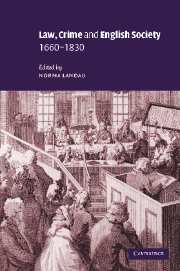Book contents
- Frontmatter
- Contents
- List of figures
- Notes of contributors
- 1 Introduction
- Part 1 Law
- Part 2 Crime
- Part 3 Society
- 8 After Somerset: Mansfield, slavery and the law in England, 1772–1830
- 9 Religion and the Law: evidence, proof and ‘matter of fact’, 1660–1700
- 10 The press and public apologies in eighteenth-century London
- 11 Origins of the factory acts: The Health and Morals of Apprentices Act, 1802
- John M. Beattie's publications
- Index
9 - Religion and the Law: evidence, proof and ‘matter of fact’, 1660–1700
from Part 3 - Society
Published online by Cambridge University Press: 30 June 2009
- Frontmatter
- Contents
- List of figures
- Notes of contributors
- 1 Introduction
- Part 1 Law
- Part 2 Crime
- Part 3 Society
- 8 After Somerset: Mansfield, slavery and the law in England, 1772–1830
- 9 Religion and the Law: evidence, proof and ‘matter of fact’, 1660–1700
- 10 The press and public apologies in eighteenth-century London
- 11 Origins of the factory acts: The Health and Morals of Apprentices Act, 1802
- John M. Beattie's publications
- Index
Summary
While it has long been recognized that English legal thought had a role to play in political and constitutional thinking, it has less often been noticed that legal thinking played a significant role in English religious discourse. I explore one facet of that influence here as I examine how the legal concept of ‘matter of fact’ and legal methods of proving ‘matters of fact’ were applied by Restoration religious thinkers to issues and topics that were far removed from the courts.
The English legal tradition of fact-finding was indebted to the continental Romano-canon legal tradition that had developed a complex evidentiary system during the Middle Ages. In that system witnesses played a key role and criteria were developed to assess the credibility of witnesses and to exclude incompetent, biased or interested testimony. In serious criminal offences where the evidence of two good witnesses or the confession that constituted ‘full proof’ was lacking, the testimony of less credible witnesses, a single witness or a variety of indicia were sufficient for a judge to order judicial torture of the defendant, torture designed to elicit the confession that would constitute full proof. Drawn from the ancient rhetorical tradition, these indicia included the age, sex, education, social status and reputation of the accused. Similar criteria were invoked in assessing witness credibility and circumstantial evidence. In some kinds of crimes ‘signs’, or ‘circumstances’, treated as presumptions of various strengths might also constitute sufficient proof.
The Romano-canon system distinguished between fact and law.
- Type
- Chapter
- Information
- Law, Crime and English Society, 1660–1830 , pp. 185 - 207Publisher: Cambridge University PressPrint publication year: 2002



